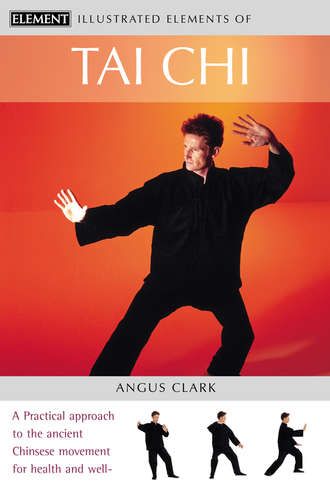
Полная версия
Tai Chi: A practical approach to the ancient Chinese movement for health and well-being
When tai chi is practiced regularly, a combination of mindset, visualization, body shape (the positions made by the body), and movement create the conditions for streams of energy to flow vigorously through the body, stimulating the internal systems. It is said in the ancient writings on tai chi that the chi (life energy) follows the mind – each posture cultivates a different kind of energy flow, depending on visualization and the body shapes it makes. The hands are transmitters for this energy, and become charged by the large amounts of information that pass through them.
Healing is a natural force that cannot be made to take place, any more than a plant can be made to grow. The role of the individual in the process is to try, through tai chi, to create the conditions in which energy can flow, and to give the body time to heal itself.
MASSAGE
The idea in massage for tai chi is to develop your spontaneity and intuition for self-healing. There are no special strokes to apply, and you need not worry about direction or pressure of stroke. Begin by following your own feelings about what to do. Rub briskly if you want to, or stroke gently.
MASSAGING THE FACE
Bring both hands to your chin and slowly draw them up over your face, back through your hair, and down your neck. Repeat five times.
MASSAGING THE EARS
Rub the lobes of each ear vigorously, then run your finger and thumb around the rim of the ear and back again to each ear lobe.
MASSAGING THE EYES
Close your eyes and (always with clean hands) stroke the upper eyelids lightly with the middle finger from close to the top of the nose out to the side of the head. Repeat this action at least seven times, then stroke the bottom eyelid in the same way.
MASSAGING THE FEET
Massaging your feet stimulates the nerve-endings and is relaxing and comforting. Hold or rub your feet one at a time for at least two minutes each.
MASSAGING THE HANDS
Massage stimulates the many nerve-endings in the hands, improving the circulation and bringing life to them. Gently or vigorously rub your hands. Pay attention to each finger and both thumbs, the palms, and the backs of the hands.
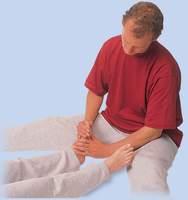
The feet work hard, yet they tend to be neglected. They benefit from massage, especially before and after practice.
SELF-HEALING
Tai chi is a healing art and just practicing it generates the energy that makes healing possible. The following exercises act as a useful complement to this aspect of tai chi. They can be done at any time, but they are especially effective immediately after practice.
HANDS ON
1 Place your left hand on the lower tantien energy center, just below the navel, and your right hand on top of it. Rest in this position for two to five minutes. Concentrate on gathering into yourself and recharging your batteries.
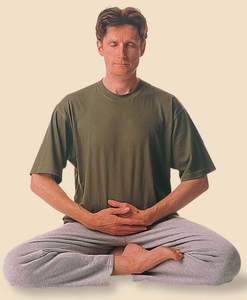
HANDS ON
2 Release your hands, place your right hand on the lower tantien and your left hand on the center of your chest. Again, hold this position for two to five minutes, concentrating on gathering into yourself and charging your batteries.
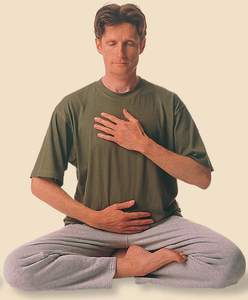
Seven Qualities
EVERY POSTURE IN tai chi is a combination of seven basic qualities. Central to these qualities is the concept of yin and yang, the forces of change and harmony. Like yin and yang, the basic qualities of tai chi are almost all polarities: open and closed; full and empty. The exception is the seventh, central equilibrium. Consciousness of these seven qualities pervades every aspect of a posture. They are the focus of the mind, they are expressed in the movements, and they are the message communicated through the very spirit of the posture.
The nonstop sequence of movements called the form is the essence of the art of tai chi. The postures are in a state of perpetual transformation, a cycle of harmony and change. A posture begins, grows, reaches a fullness, and starts to empty, ready for the growth of the next one.
To fulfil their task of restoring equilibrium between yin and yang, the movements of the form must be executed with the correct technique and mind intent (attitude). Often for a beginner, body and mind are too fully occupied with learning the sequence of movements and the technique to experience the qualities of each movement. So, to accompany the form practice, experiment with moves that develop a sense of feeling, such as relaxing your muscles and moving your weight from one side to the other.
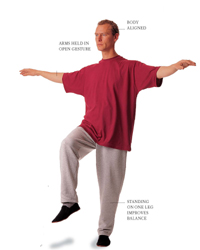
Balance improves by standing on each leg in turn for a few minutes each day. This strengthens the legs and improves the coordination, but it also makes you feel different. Physical equilibrium infiltrates the mental and emotional spheres of your being.
All postures contain the polarities of open and closed. Open is generally associated with gathering energy and closed with releasing. At each moment every part of the body is either open or closed, so studying one’s own posture helps in understanding the concept. Bringing the hands together as if clapping, carries the feeling of closed. Open is felt when lifting the arms outward as when welcoming friends.
The polarities of full and empty give the body mobility. In tai chi balance is held in one side, leaving the other free to move. The balance empties from one side and fills the other, as the exercise Balanced Walking demonstrates, increasing mobility. Open or closed, the body must be in balance.
Without equilibrium a posture will lose its structure, becoming too open or too closed. Structure lends strength to a posture. Central equilibrium is the foundation of every stance and the hub of every movement. When a posture is based on central equilibrium, the body is aligned between earth and sky, so it is perfectly balanced.
Beginners unfamiliar with these ideas find it hard to combine the mental concept with the physical experience. Familiarity makes these qualities more and more interesting, however, since they affect almost every aspect of every tai chi movement. Familiarizing yourself with them therefore needs to become part of regular practice.
EXPERIENCE YOUR BODY SHAPES
Create your own body shapes to express the qualities of yin and yang described previously. As a guide for yin, use soft, round, smooth, flowing shapes to embody the qualities. For yang use hard, angular, and linear shapes as your guiding concepts. Play with all these possibilities and add your own movements.
You can discover how open and closed feel when expressed as movement. As you practice, the polarity intensifies the experience of the movement.
The second exercise expands the first to make greater demands on your imagination. Imagine yourself as an empty vessel; picture the reality of fullness.
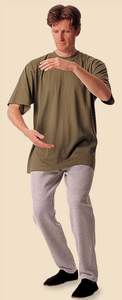
YIN BODY SHAPE
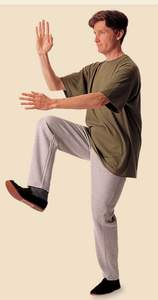
YANG BODY SHAPE
OPEN AND CLOSED
1 Stand with your feet apart, lift your arms up and out in a welcoming gesture, and imagine each body part and your feelings opening up.
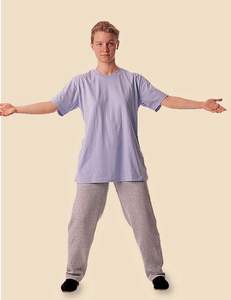
OPEN AND CLOSED
2 Slowly draw your arms in, crossing them over your chest, contemplating this closed position. End by lowering your arms and standing erect for a while.
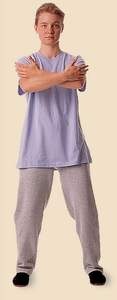
FULL AND EMPTY
1 Imagine colored liquid filling you from your feet up. Experience every cell in your body expanding as it rises, moving your arms out as if you are inflating.
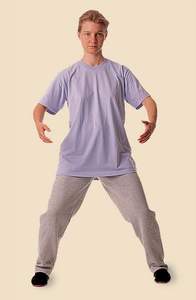
FULL AND EMPTY
2 Then close your eyes and imagine your body is hollow. Visualize yourself becoming emptiness.
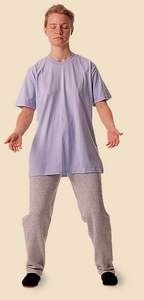
Seven Steps to Progress
TAI CHI OFFERS more than exercises for health, it also provides a program for self-development. The influential teachers Cheng Man-ch’ing and Chi Chiang-tao mapped out a sevenfold path to tai chi practice. For just as the postures are composed of seven basic qualities, so there are seven dimensions to practice, seven steps to progress through the form.
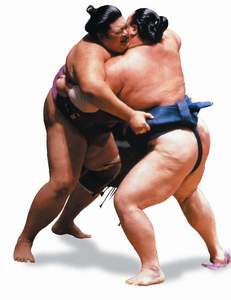
Tai chi teaches you to respond to a partner’s movements. Sumo wrestlers use force against force.
Imagine trying to stop the flow of a river or make it flow faster. The way of tai chi is always to flow with the river. Beginners may be surprised to find that they have been conditioned to fight the river’s natural flow, to use force against force. We are trained to keep to timetables and meet deadlines rather than follow the natural rhythms of our body and mind.
Tai chi teaches people to correct this imbalance by becoming alert to intelligence from within while learning to listen to what is happening outside and to respond to others. It teaches patience, the ability to wait, poised and quiet, for the right moment to move or act.
When tai chi movements are performed correctly, they work to calm and focus the mind, so that mind, energy, and body work in harmony. The seven dimensions of tai chi practice are described next, and represented on the graph.
MAPPING TAI CHI PRACTICE
The seven dimensions of tai chi practice, described previously, may be represented by a graph on which you map your progress along the path to natural way. The vertical axis measures your progress on a scale from 1 to 10. A teacher might help you assess your abilities in each area. Draw a new graph to review progress after a year. Your tendency to use force against force should have fallen and your energy and coordination have risen.
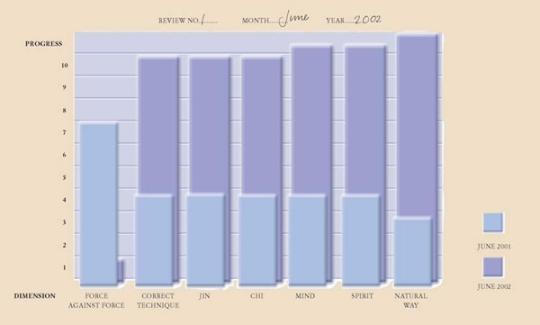
FORCE AGAINST FORCE
Are you trying to dominate by blocking your partner’s responses, or responding too quickly, before your partner stops pushing? If so, you are using force against force. In this interaction you enter into a dialog, inviting your partner to respond to your push. Do not try to force one. When receiving a push, listen as the movement unfolds, knowing that each push has its lifetime. Do not stop it by force, but move in response to the other person. This is the natural way.
CORRECT TECHNIQUE
Although the rules of tai chi are challenging, they are effective. Hands and feet need to be correctly aligned, placed, and arranged; doing this enables you to reap the richest reward from practice. And bear in mind that improvement often comes without a struggle. Working on the mind, for instance, sharpens concentration, which brings about improvements in technique.
JIN OR WHOLE BODY ENERGY
Beginners feel all left feet. As practice evolves, feet, legs and pelvis, spine, arms, and hands feel more connected, and movements of head and body begin to feel coordinated. There comes a time when breathing and movement of all parts of the body follow one rhythm, and this cohesion is jin (whole body energy).
CHI OR LIFE FORCE ENERGY
Tai chi movements stimulate the chi circulating in the body and the musculoskeletal system, exercise the internal organs, and open the meridians, allowing chi to build. Resting the mind quietly in the lower tantien energy center after practice also builds chi. People often feel contentment and greater vitality after practice.
MIND
Cultivating awareness is the key to mind control – if your mind keeps returning to one of the day’s events while you are practicing, acknowledge it. Notice where your mind is directed as you move. Soon, there will be moments when it becomes absorbed in the moves you are making, and the moments will extend to minutes. Then you find your mind making visualizations at will.
SPIRIT
There is a dynamic equilibrium between earth and spirit in tai chi. The way to spirit is through the earthing of the body, and the stronger the connection with the earth, the greater the possibilities for spirit. One of the joys of practice is allowing the body to radiate the spirit that powers each posture – the spirit of fire or of clarity. Enjoy the spirit of the moment; you may feel poised, like a cat about to pounce, then you might become quiet, nurturing the spirit inside.
NATURAL WAY
Follow the natural way to emerge into the seventh dimension. Let go of the binding patterns of force against force, become receptive to the natural way of things, and learn to wait for the right moment to move. Attaining natural way is a sevenfold process. The qualities work together to realign the whole person toward natural way.
MIND GAME
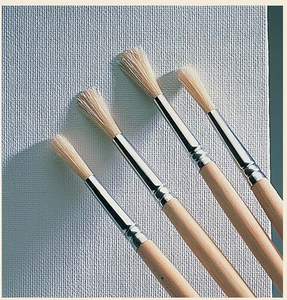
This visualization may take a while to become real, but it will show how your mind and your energy can work together. Turn your left palm toward you. Point the fingers of your right hand toward your left palm keeping them about six inches away. Imagine the fingers of your right hand are brushes. Paint strokes very slowly over your left hand. At first you may not sense anything, but soon you will feel the light brush strokes moving across the sensitive palm of your hand as clearly as if you were really painting it.
Movement, Health, and Body Awareness
THE BODY IS an extraordinary, wonderful instrument. It is mechanically well designed and physically intricate, yet it also houses the spirit. The body bestows on its owner the gift of movement, yet people living a modern lifestyle rarely if ever make the most of this ability, and many have forgotten or never discovered their bodies’ capabilities. Yet not only is the body designed to move, it needs to, in order to stay healthy. Tai chi provides a form of exercise that offers a remedy for the ills of modern living, a supportive answer to the body’s need to move.
While they are still developing in their mother’s womb, unborn infants know how to move. They swim, dance, push, wriggle, and kick. Immediately after birth, babies move instinctively and without inhibition, and during the early years, movement plays an essential part in childhood learning and personal development. Young children crawl, roll, totter, and fall; as they grow they play on swings, slides, roundabouts, and with each other. A child’s world is largely body-based.
Relatively few adults in modern industrial countries still have to cut hay, harvest crops, fetch water, or chop wood by hand in order to survive. Most are relieved of such tiresome tasks and chores by modern economic organization, which uses machines to perform repetitive jobs, releasing people to attend to tasks carried out by telephone, pager, fax, or computer, reached by automobile, rail or air link, e-mail or internet. Many are not forced by their work to stretch or stress their bodies. Problems tend to begin shortly after the point where demands cease to be made of the body. Arthritis, for example, is associated with under-exercising the joints. One physiologist has estimated that 150 years of good service could normally be expected from the superbly designed joints of the human frame. Yet they waste away, working at a fraction of their potential, while the body sits on office chairs or lounges on sofas.
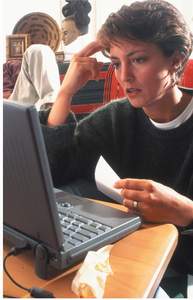
A sedentary lifestyle now can mean mobility problems later on in life.
By placing emphasis on mental achievement and a globalizing electronic culture, contemporary living draws energy from the body into the head, simply because exercising the mind draws blood to the brain. The ratio of mental and emotional stimulation to physical activity was reversed during the 20th century, and for many the reversal took place in fewer than 50 years. Modern work stresses the mind but fails to work the body, making true rest difficult to achieve.
Western society today is predominantly sedentary. Anyone doing an office or a driving job is required to sit for long periods. Then, at the end of the day they rest in a sitting position, unlike most animals, which tend to rest lying down. Tribal peoples who retain their ancient customs often rest by squatting, kneeling, or lying. Modern people sit on a chair, on the tail of the spine, a position that far from being restful is a kind of slump. In time, this bad posture can result in a tendency to asthma, lower back trouble, and prolapsed (displaced) internal organs.
Sitting back to relax and watch TV sets up another dynamic. The body responds to the visual stimuli presented on a screen by producing an emotional response in the form of energy that needs to find expression. Aware of the need for an outlet for such unexpressed energy, many people take up some form of exercise. It is all too easy, however, to overreact and pummel the body with exercise. Activity that is too vigorous can shock the body and injure its systems.
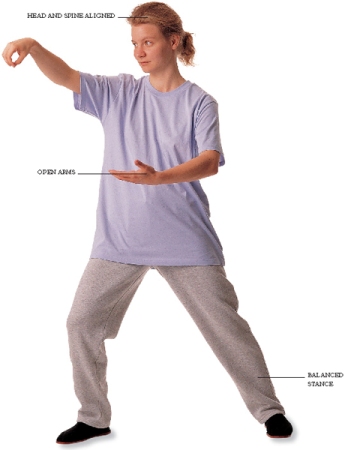
Tai chi is a holistic practice, its movements exercise the whole body, not just individual muscles or muscle groups. It works gently to encourage the body's natural harmony.
Tai chi is quality movement. It is physically demanding, yet it works with the body to encourage the gradual developing of strength and reviving of natural openness and coordination. This process is not something that can be hurried, however. Tai chi is an art that needs to be mastered through gradual learning and practice, but the benefits of investing time and effort in it become apparent very early on.
Like a door, the body must be kept moving to prevent its hinge joints – and other types of joint – from seizing up, and tai chi works to condition the elements of the human frame. It promotes greater understanding of the body’s natural alignment and stance, encouraging the habit of good posture. Its movements continually turn the spine, an action that gradually repositions misplaced organs, stimulating them at the same time through an internal form of massage. The tai chi movements dissipate excess nervous tension held in the body and so help balance the nervous system. Through apparently simple exercises, such as standing on one leg, tai chi stimulates the muscle groups to work together. Continued through life it prevents the joints of the hips and limbs from degenerating.
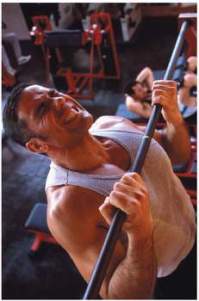
Working out can demand too much of the body without considering its needs and tolerances.
The unique upright stance of humans gives us a greater potential for movements than creatures who walk on four legs. The physical capabilities of humans may seem inferior when in water, yet it is the human who can walk out of the water onto the land, play volleyball, climb a tree, paint a picture, and cook a meal. Each day, our bodies perform wonders for us.
But do we know our bodies? The next section presents some of the workings of the body from a holistic point of view, from the mechanical structure of the frame to the internal systems and the location of the energy centers, and shows how tai chi encourages the development of a personal connection with the body.
The Skeleton
THE BODY’S ARCHITECTURE provides the framework for the extraordinary variety of movement and bodily expression that is tai chi. The art makes full use of the combination of dexterity, flexibility, articulation, and movement capabilities that the skeleton, aided by ligaments, muscles, and tendons, makes possible. Knowing the basics of body architecture will deepen understanding of the tai chi postures. It will also give a sense of wonder at the sheer variety of movements the human body can perform, unparalleled in the rest of the animal kingdom.
The skeleton is the body’s frame, supporting it and giving it shape. The bony cavities of the skull, the rib cage, and the pelvic girdle provide protection for the body’s vital organs – the brain, the lungs, the organs of digestion, and the sexual organs. Design of the skeleton has evolved over millions of years to make it perfectly adapted for movement. The girders of a building are bolted into a rigid framework, but the skeletal bones are connected by joints held together by ligaments and operated by muscles. This system gives the body mobility.
Tai chi actively increases mobility in all the joints of the body, maintaining an especially strong focus on the ankles, knees, hips, shoulders, elbows, wrists, and spine. It achieves this mainly by encouraging the joints to open, that is, to relax completely.
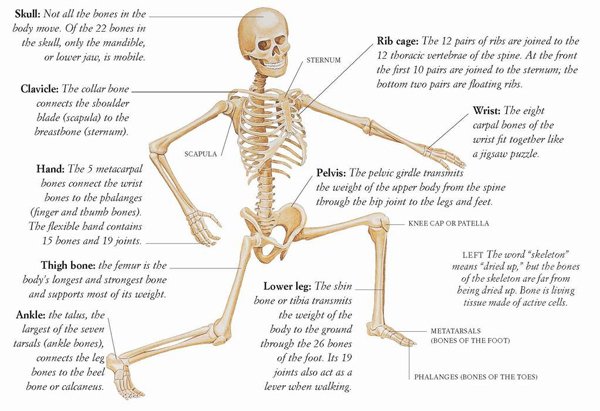
Bone is living tissue made of active cells served by blood vessels and nerves, and the tissues in its spongy center carry out the vital task of making bone marrow. The red blood cells, which transport oxygen, are formed in the bone marrow along with white blood cells, which fight infection. Bones are fundamental to the body’s immune system.
Tai chi attributes another important function to the bone marrow. The teacher Cheng Man-ch’ing described the cultivation of chi in the lower tantien energy center, how it warms the fluids of the body and fills the hollow spaces of the bones. An adhesive substance forms, which turns into marrow and plates the insides of the bones like nickel or gold, giving them greater weight and pure hardness.


